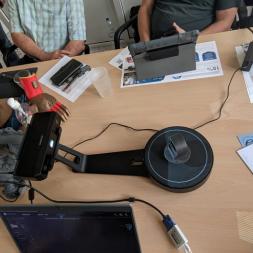
Reverse Engineering course
This course is intended for any teacher or educator who desires to use 3D design/scanning/printing technology in the classroom to increase or develop their students' creativity and design-thinking mindset.
The reverse engineering process includes 3D scanning an object and a) 3D printing directly for cloning or b) modifying the object (3D design) & then 3D printing an improved version.
Description
Engineering is a very versatile industry that is always getting creative. Using creativity and innovation, engineers create never-before-seen products that benefit their communities. They play a key role in expanding the local economy and sparking business exchanges. However, one question remains: how do engineers innovate in such a fast-paced environment?
The answer is the reverse, literally. Reverse engineering plays a huge role in sparking innovative and productive minds that produce necessities across every industry. The reverse engineering process includes taking apart worn-down products to examine how individual parts work, and then incorporating past inventions into new ones. Reverse engineering is very common in such diverse fields as software engineering, entertainment, automotive, consumer products, microchips, chemicals, electronics, and mechanical designs. For example, when a new machine comes to market, competing manufacturers may buy one machine and disassemble it to learn how it works.
Learning objectives
- Provide teachers/educators/trainers with practical ideas for how they can incorporate 3D printing & scanning technology into their existing lessons.
- Bring in contact teachers/educators with the amazing world of 3D printing & scanning technology.
- Provide educators/teachers with the knowledge and skills to design and print a 3D subject for their classroom.
- Provide educators/teachers with the knowledge and skills to 3D scan an object and improve its function by applying modifications throughout 3d design.
- Introduction of the Design Thinking Process.
- Demonstrate its appropriateness for Project Based Learning (PBL) implementation.
Methodology & assessment
Demonstration: The hardware, parts and basic setup of a 3D scanner, a 3D printer and 3D scanning apps for smartphones will be explained to the trainees.
Learning by doing: The trainees will actively engage with the 3D technologies, trying to scan/print/design objects useful for their lessons.
Formative assessment: During the course, the trainers will estimate the level of trainees and adjust the content of the course according to the individual needs of the trainees.
Materials, digital tools & other learning resources
We are going to provide all the necessary digital tools.
Certification details
1. We provide a personal Certification of Attendance indicating the total training hours (35 hours) and the organization of each participant.
2. We provide a Europass certification indicating the gained skills and learning outcomes.
Pricing, packages and other information
-
Price:560Euro
-
Course package content:
-
-
Additional information:Description of the services and activities included in the course package (such as accommodation, meals, transport) or available at extra cost.
-
Cancellation & changes:
-
-
Additional information:The options and conditions for change and cancellation, and the policy in case of unforeseen circumstances (force majeure).
Additional information
-
Language:English
-
Target audience ISCED:Lower secondary education (ISCED 2)Upper secondary education (ISCED 3)Post-secondary non-tertiary education (ISCED 4)
-
Target audience type:TeacherHead Teacher / PrincipalICT Coordinator
-
Learning time:25 hours or more
Upcoming sessions
Past sessions
More courses by this organiser

Green Horizons: Empowering Educators in Sustainable 3D Printing and STEM Design
3d Printing: Fostering creativity to your students


